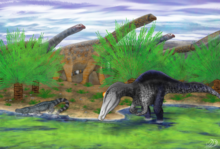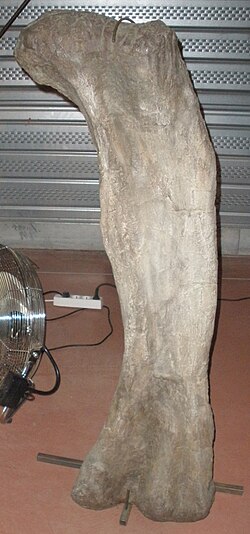Phuwiangosaurus
Stratigrafický výskyt: Spodní křída, asi před 134 až 132 miliony let | |
|---|---|
 Stehenní kost fuviangosaura | |
| Vědecká klasifikace | |
| Říše | živočichové (Animalia) |
| Kmen | strunatci (Chordata) |
| Třída | plazi (Sauropsida) |
| Nadřád | dinosauři (Dinosauria) |
| Řád | plazopánví (Saurischia) |
| Podřád | Sauropodomorpha |
| Infrařád | Sauropoda |
| Čeleď | Euhelopodidae |
| Rod | Phuwiangosaurus Martin, Buffetaut a Suteethorn, 1994 |
| Binomické jméno | |
| Phuwiangosaurus sirindhornae Martin, Buffetaut a Suteethorn, 1994 | |
| Některá data mohou pocházet z datové položky. | |
Phuwiangosaurus („ještěr z Phu Wiangu (Thajska)“) byl rod velkého titanosaurního sauropodního dinosaura z čeledi Euhelopodidae, žijícího v období spodní křídy na území dnešního Thajska.[1]
Objev a zařazení

Fosilie tohoto dinosaura byly objeveny v sedimentech souvrství Sao Khua a mají stáří asi 134 až 132 milionů let.[2] Typový druh P. sirindhornae byl pojmenován na počest princezny Maha Chakri Sirindhornové, která se zajímá o geologii a paleontologii Thajska. Tento dinosaurus byl mohutný čtyřnohý býložravec, dosahující délky asi 19 metrů a hmotnosti kolem 17 tun.[3] Jiný odhad předpokládá délku až 25 metrů a hmotnost asi 20 tun.[4] Původně byl klasifikován jako titanosaur nebo nemegtosaurid, novější studie jej ale řadí spíše do čeledi euhelopodidů. Mohlo se také jednat o zástupce kladu Laurasiformes.
Ekosystém
Spolu s tímto rodem sauropoda se ve stejných ekosystémech vyskytovali také teropodi Siamosaurus, Siamotyrannus a Kinnareemimus, dále pak zde byly objeveny fosilie dosud neidentifikovaného sauropoda a jiného teropoda.
Odkazy
Reference
- ↑ Siripat Kaikaew, Varavudh Suteethorn, Uthumporn Deesri & Suravech Suteethorn (2022). The endocast of Phuwiangosaurus sirindhornae from the Lower Cretaceous of Thailand. Cretaceous Research. 105434. doi: https://doi.org/10.1016/j.cretres.2022.105434
- ↑ Tucker, R. T.; et al. (2022). Age, depositional history, and paleoclimatic setting of Early Cretaceous dinosaur assemblages from the Sao Khua Formation (Khorat Group), Thailand. Palaeogeography, Palaeoclimatology, Palaeoecology. 111107. doi: https://doi.org/10.1016/j.palaeo.2022.111107
- ↑ Paul, G. S. (2010). The Princeton Field Guide to Dinosaurs. Princeton University Press, str. 205 (anglicky)
- ↑ Holtz, Thomas R., Jr.; Rey, Luis V. (2007). Dinosaurs: The Most Complete, Up-to-Date Encyclopedia for Dinosaur Lovers of All Ages (Aktualizovaný internetový dodatek). New York: Random House. ISBN 978-0-375-82419-7.
Literatura
- MARTIN, V., BUFFETAUT, E. and SUTEETHORN, V. (1994). A new genus of sauropod dinosaur from the Sao Khua formation (Late Jurassic or early Cretaceous) of northeastern Thailand. Comptes Rendus de l’ Academie des Science de Paris. 319(2): 1085-1092.
- MARTIN, V., SUTEETHORN, V. and BUFFETAUT, E. (1999). Description of the type and referred material of Phuwiangosaurus sirindhornae Martin, Buffetaut and Suteethorn, 1994, a sauropod from the Lower Cretaceous of Thailand. Oryctos 2: 39-91.
- M. D. D'Emic. (2012). The early evolution of titanosauriform sauropod dinosaurs. Zoological Journal of the Linnean Society 166: 624-671.
- M. D. D'Emic. (2013). Revision of the sauropod dinosaurs of the Lower Cretaceous Trinity Group, southern USA, with the description of a new genus. Journal of Systematic Palaeontology 11(6): 707-726.
- P. D. Mannion, P. Upchurch, R. N. Barnes and O. Mateus. (2013). Osteology of the Late Jurassic Portuguese sauropod dinosaur Lusotitan atalaiensis (Macronaria) and the evolutionary history of basal titanosauriforms. Zoological Journal of the Linnean Society 168: 98-206.
- P. Mocho, R. Royo-Torres, and F. Ortega. (2014). Phylogenetic reassessment of Lourinhasaurus alenquerensis, a basal Macronaria (Sauropoda) from the Upper Jurassic of Portugal. Zoological Journal of the Linnean Society 170: 875-916.
Externí odkazy
 Obrázky, zvuky či videa k tématu Phuwiangosaurus na Wikimedia Commons
Obrázky, zvuky či videa k tématu Phuwiangosaurus na Wikimedia Commons - Informace na webu Prehistoric Wildlife (anglicky)
- Profil na databázi Fossilworks Archivováno 14. 7. 2020 na Wayback Machine. (anglicky)
- Informace na webu DinoData (německy)
- Informace na webu DinoChecker (anglicky)
- Informace na webu Equatorial Minnesota (anglicky)
Média použitá na této stránce
Autor:
- Information-silk.png: Mark James
- derivative work: KSiOM(Talk)
A tiny blue 'i' information icon converted from the Silk icon set at famfamfam.com
Autor: Based on sketch by: Offy, new digital iteration of drawing with more fauna, colour, and amplified detail by: PaleoGeekSquared, Licence: CC BY-SA 4.0
Restoration of the spinosaurid dinosaur Siamosaurus in the Sao Khua Formation palaeoenvironment, with Sunosuchus in the middle left and a herd of Phuwiangosaurus in the background.
- References:
Siamosaurus based on tooth specimens [1] and the neural spine of a possibly referable skeleton[2], with other missing elements filled in with relatives (Suchomimus[3], Baryonyx[4], IchthyovenatorFile:Ichthyovenator_laosensis_skeletal_reconstruction_by_PaleoGeek.png).
Phuwiangosaurus based on skeletal by Suteethorn et al. (2009)[5] and missing elements of skull of EuhelopusFile:Euhelopus.png.
Sunosuchus based on Suteethorn and Ingavat (1983)[6] and missing elements based on Goniopholis[7].Autor: Ghedoghedo, Licence: CC BY-SA 3.0
fossil femur of Phuwiangosaurus sirindhornae, an extinct sauropod


